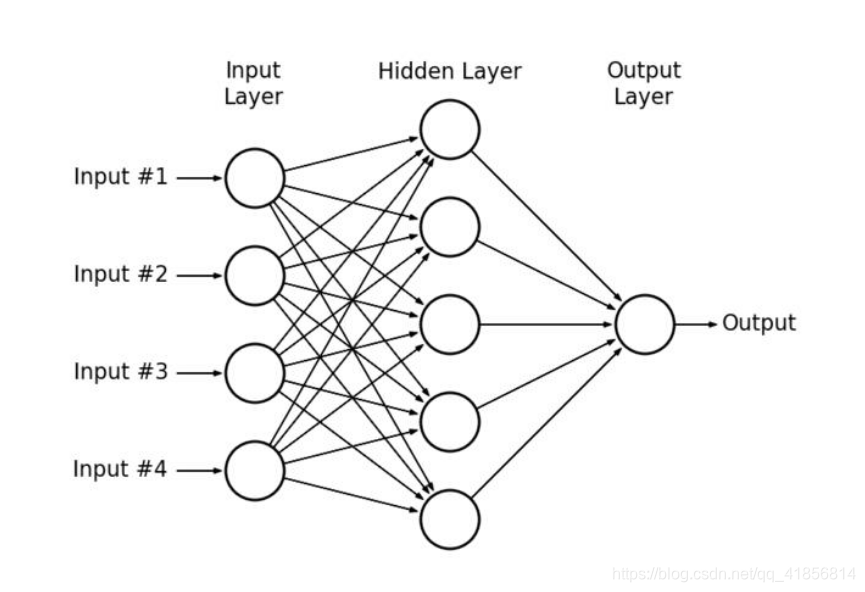卷积神经网络的概念
在多层感知器(Multilayer Perceptrons,简称MLP)中,每一层的神经元都连接到下一层的所有神经元。一般称这种类型的层为完全连接。

多层感知器示例
反向传播
几个人站成一排第一个人看一幅画(输入数据),描述给第二个人(隐层)……依此类推,到最后一个人(输出)的时候,画出来的画肯定不能看了(误差较大)。
反向传播就是,把画拿给最后一个人看(求取误差),然后最后一个人就会告诉前面的人下次描述时需要注意哪里(权值修正)
其实反向传播就是梯度下降的反向继续
什么是卷积:convolution
卷积运算
计算步骤解释如下,原图大小为7*7,通道数为3:,卷积核大小为3*3,Input Volume中的蓝色方框和Filter W0中红色方框的对应位置元素相乘再求和得到res(即,下图中的步骤1.res的计算),再把res和Bias b0进行相加(即,下图中的步骤2),得到最终的Output Volume
卷积示例
以下是一组未经过滤的猫咪照片:


如果分别应用水平和垂直边缘滤波器,会得出以下结果:

可以看到某些特征是变得更加显著的,而另一些特征逐渐消失。有趣的是,每个过滤器都展示了不同的特征。
这就是卷积神经网络学习识别图像特征的方法。
卷积函数如下:卷积函数tf.nn.conv2d
第一个参数:input [训练时一个batch图像的数量,图像高度,图像宽度, 图像通道数])
第二个参数:filter
filter就是卷积核(这里要求用Tensor来表示卷积核,并且Tensor(一个4维的Tensor,要求类型与input相同)的shape为[filter_height, filter_width, in_channels, out_channels]具体含义[卷积核高度,卷积核宽度,图像通道数,卷积核个数],这里的图片通道数也就input中的图像通道数,二者相同。)

第三个参数:strides
strides就是卷积操作时在图像每一维的步长,strides是一个长度为4的一维向量
第四个参数:padding
第五个参数:use_cudnn_on_gpu
第六个参数:data_format
NHWC:[batch, height, width, channels]
第七个参数:name
padding是一个string类型的变量,只能是 "SAME" 或者 "VALID",决定了两种不同的卷积方式。下面我们来介绍 "SAME" 和 "VALID" 的卷积方式,如下图我们使用单通道的图像,图像大小为5*5,卷积核用3*3
如果以上参数不明白如何使用如下示例:
简单的单层神经网络预测手写数字图片
import tensorflow as tf
from tensorflow.examples.tutorials.mnist import input_data
from tensorflow.contrib.slim.python.slim.nets.inception_v3 import inception_v3_base
FLAGS = tf.app.flags.FLAGS
tf.app.flags.DEFINE_integer("is_train", 1, "指定程序是预测还是训练")
def full_connected():
# 获取真实的数据
mnist = input_data.read_data_sets("./data/mnist/input_data/", one_hot=True)
# 1、建立数据的占位符 x [None, 784] y_true [None, 10]
with tf.variable_scope("data"):
x = tf.placeholder(tf.float32, [None, 784])
y_true = tf.placeholder(tf.int32, [None, 10])
# 2、建立一个全连接层的神经网络 w [784, 10] b [10]
with tf.variable_scope("fc_model"):
# 随机初始化权重和偏置
weight = tf.Variable(tf.random_normal([784, 10], mean=0.0, stddev=1.0), name="w")
bias = tf.Variable(tf.constant(0.0, shape=[10]))
# 预测None个样本的输出结果matrix [None, 784]* [784, 10] + [10] = [None, 10]
y_predict = tf.matmul(x, weight) + bias
# 3、求出所有样本的损失,然后求平均值
with tf.variable_scope("soft_cross"):
# 求平均交叉熵损失
loss = tf.reduce_mean(tf.nn.softmax_cross_entropy_with_logits(labels=y_true, logits=y_predict))
# 4、梯度下降求出损失
with tf.variable_scope("optimizer"):
train_op = tf.train.GradientDescentOptimizer(0.1).minimize(loss)
# 5、计算准确率
with tf.variable_scope("acc"):
equal_list = tf.equal(tf.argmax(y_true, 1), tf.argmax(y_predict, 1))
# equal_list None个样本 [1, 0, 1, 0, 1, 1,..........]
accuracy = tf.reduce_mean(tf.cast(equal_list, tf.float32))
# 收集变量 单个数字值收集
tf.summary.scalar("losses", loss)
tf.summary.scalar("acc", accuracy)
# 高纬度变量收集
tf.summary.histogram("weightes", weight)
tf.summary.histogram("biases", bias)
# 定义一个初始化变量的op
init_op = tf.global_variables_initializer()
# 定义一个合并变量de op
merged = tf.summary.merge_all()
# 创建一个saver
saver = tf.train.Saver()
# 开启会话去训练
with tf.Session() as sess:
# 初始化变量
sess.run(init_op)
# 建立events文件,然后写入
filewriter = tf.summary.FileWriter("./tmp/summary/test/", graph=sess.graph)
if FLAGS.is_train == 1:
# 迭代步数去训练,更新参数预测
for i in range(2000):
# 取出真实存在的特征值和目标值
mnist_x, mnist_y = mnist.train.next_batch(50)
# 运行train_op训练
sess.run(train_op, feed_dict={x: mnist_x, y_true: mnist_y})
# 写入每步训练的值
summary = sess.run(merged, feed_dict={x: mnist_x, y_true: mnist_y})
filewriter.add_summary(summary, i)
print("训练第%d步,准确率为:%f" % (i, sess.run(accuracy, feed_dict={x: mnist_x, y_true: mnist_y})))
# 保存模型
saver.save(sess, "./tmp/ckpt/fc_model")
else:
# 加载模型
saver.restore(sess, "./tmp/ckpt/fc_model")
# 如果是0,做出预测
for i in range(100):
# 每次测试一张图片 [0,0,0,0,0,1,0,0,0,0]
x_test, y_test = mnist.test.next_batch(1)
print("第%d张图片,手写数字图片目标是:%d, 预测结果是:%d" % (
i,
tf.argmax(y_test, 1).eval(),
tf.argmax(sess.run(y_predict, feed_dict={x: x_test, y_true: y_test}), 1).eval()
))
return None
# 定义一个初始化权重的函数
def weight_variables(shape):
w = tf.Variable(tf.random_normal(shape=shape, mean=0.0, stddev=1.0))
return w
# 定义一个初始化偏置的函数
def bias_variables(shape):
b = tf.Variable(tf.constant(0.0, shape=shape))
return b
def model():
"""
自定义的卷积模型
:return:
"""
# 1、准备数据的占位符 x [None, 784] y_true [None, 10]
with tf.variable_scope("data"):
x = tf.placeholder(tf.float32, [None, 784])
y_true = tf.placeholder(tf.int32, [None, 10])
# 2、一卷积层 卷积: 5*5*1,32个,strides=1 激活: tf.nn.relu 池化
with tf.variable_scope("conv1"):
# 随机初始化权重, 偏置[32]
w_conv1 = weight_variables([5, 5, 1, 32])
b_conv1 = bias_variables([32])
# 对x进行形状的改变[None, 784] [None, 28, 28, 1]
x_reshape = tf.reshape(x, [-1, 28, 28, 1])
# [None, 28, 28, 1]-----> [None, 28, 28, 32]
x_relu1 = tf.nn.relu(tf.nn.conv2d(x_reshape, w_conv1, strides=[1, 1, 1, 1], padding="SAME") + b_conv1)
# 池化 2*2 ,strides2 [None, 28, 28, 32]---->[None, 14, 14, 32]
x_pool1 = tf.nn.max_pool(x_relu1, ksize=[1, 2, 2, 1], strides=[1, 2, 2, 1], padding="SAME")
# 3、二卷积层卷积: 5*5*32,64个filter,strides=1 激活: tf.nn.relu 池化:
with tf.variable_scope("conv2"):
# 随机初始化权重, 权重:[5, 5, 32, 64] 偏置[64]
w_conv2 = weight_variables([5, 5, 32, 64])
b_conv2 = bias_variables([64])
# 卷积,激活,池化计算
# [None, 14, 14, 32]-----> [None, 14, 14, 64]
x_relu2 = tf.nn.relu(tf.nn.conv2d(x_pool1, w_conv2, strides=[1, 1, 1, 1], padding="SAME") + b_conv2)
# 池化 2*2, strides 2, [None, 14, 14, 64]---->[None, 7, 7, 64]
x_pool2 = tf.nn.max_pool(x_relu2, ksize=[1, 2, 2, 1], strides=[1, 2, 2, 1], padding="SAME")
# 4、全连接层 [None, 7, 7, 64]--->[None, 7*7*64]*[7*7*64, 10]+ [10] =[None, 10]
with tf.variable_scope("conv2"):
# 随机初始化权重和偏置
w_fc = weight_variables([7 * 7 * 64, 10])
b_fc = bias_variables([10])
# 修改形状 [None, 7, 7, 64] --->None, 7*7*64]
x_fc_reshape = tf.reshape(x_pool2, [-1, 7 * 7 * 64])
# 进行矩阵运算得出每个样本的10个结果
y_predict = tf.matmul(x_fc_reshape, w_fc) + b_fc
return x, y_true, y_predict
def conv_fc():
# 获取真实的数据
mnist = input_data.read_data_sets("./data/mnist/input_data/", one_hot=True)
# 定义模型,得出输出
x, y_true, y_predict = model()
# 进行交叉熵损失计算
# 3、求出所有样本的损失,然后求平均值
with tf.variable_scope("soft_cross"):
# 求平均交叉熵损失# 求平均交叉熵损失
loss = tf.reduce_mean(tf.nn.softmax_cross_entropy_with_logits(labels=y_true, logits=y_predict))
# 4、梯度下降求出损失
with tf.variable_scope("optimizer"):
train_op = tf.train.GradientDescentOptimizer(0.0001).minimize(loss)
# 5、计算准确率
with tf.variable_scope("acc"):
equal_list = tf.equal(tf.argmax(y_true, 1), tf.argmax(y_predict, 1))
# equal_list None个样本 [1, 0, 1, 0, 1, 1,..........]
accuracy = tf.reduce_mean(tf.cast(equal_list, tf.float32))
# 定义一个初始化变量的op
init_op = tf.global_variables_initializer()
# 开启回话运行
with tf.Session() as sess:
sess.run(init_op)
# 循环去训练
for i in range(1000):
# 取出真实存在的特征值和目标值
mnist_x, mnist_y = mnist.train.next_batch(50)
# 运行train_op训练
sess.run(train_op, feed_dict={x: mnist_x, y_true: mnist_y})
print("训练第%d步,准确率为:%f" % (i, sess.run(accuracy, feed_dict={x: mnist_x, y_true: mnist_y})))
return None
if __name__ == "__main__":
conv_fc()Tensorflow-卷积神经网络构建.

代码:
import numpy as np
import tensorflow as tf
input_ = np.random.randn(1,32,32,1).astype('float32')
filter_ = np.random.randn(5,5,1,8).astype('float32')
conv1 = tf.nn.conv2d(input_,filter_,[1,1,1,1],'VALID')
conv1 = tf.nn.relu(conv1)
# 池化
pool1 = tf.nn.max_pool(conv1,[1,2,2,1],[1,2,2,1],'SAME')
#第二层卷积
filter2_ = np.random.randn(5,5,8,20).astype('float32')
conv2 = tf.nn.conv2d(pool1,filter2_,[1,1,1,1],'VALID')
#第二层池化
pool2 = tf.nn.max_pool(conv2,[1,2,2,1],[1,2,2,1],'SAME')
#第三层卷积
filter3_ = np.random.randn(5,5,20,120).astype('float32')
conv3 = tf.nn.conv2d(pool2,filter3_,[1,1,1,1],'VALID')
#全连接层
full = tf.reshape(conv3,shape = (1,120))
W = tf.random_normal(shape = [120,9])
fc = tf.matmul(full,W)
fc
nd = np.random.randn(30)
tf.nn.relu(nd)
with tf.Session() as sess:
ret =sess.run(tf.nn.relu(nd))
print(ret)


